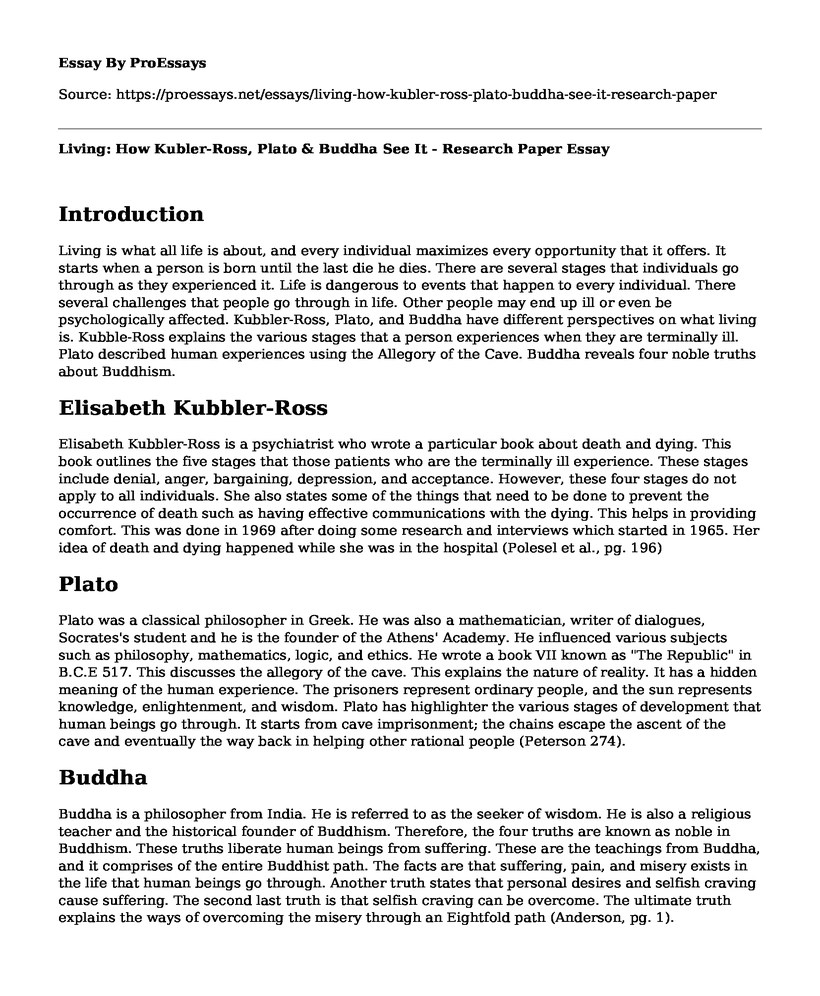Introduction
Living is what all life is about, and every individual maximizes every opportunity that it offers. It starts when a person is born until the last die he dies. There are several stages that individuals go through as they experienced it. Life is dangerous to events that happen to every individual. There several challenges that people go through in life. Other people may end up ill or even be psychologically affected. Kubbler-Ross, Plato, and Buddha have different perspectives on what living is. Kubble-Ross explains the various stages that a person experiences when they are terminally ill. Plato described human experiences using the Allegory of the Cave. Buddha reveals four noble truths about Buddhism.
Elisabeth Kubbler-Ross
Elisabeth Kubbler-Ross is a psychiatrist who wrote a particular book about death and dying. This book outlines the five stages that those patients who are the terminally ill experience. These stages include denial, anger, bargaining, depression, and acceptance. However, these four stages do not apply to all individuals. She also states some of the things that need to be done to prevent the occurrence of death such as having effective communications with the dying. This helps in providing comfort. This was done in 1969 after doing some research and interviews which started in 1965. Her idea of death and dying happened while she was in the hospital (Polesel et al., pg. 196)
Plato
Plato was a classical philosopher in Greek. He was also a mathematician, writer of dialogues, Socrates's student and he is the founder of the Athens' Academy. He influenced various subjects such as philosophy, mathematics, logic, and ethics. He wrote a book VII known as "The Republic" in B.C.E 517. This discusses the allegory of the cave. This explains the nature of reality. It has a hidden meaning of the human experience. The prisoners represent ordinary people, and the sun represents knowledge, enlightenment, and wisdom. Plato has highlighter the various stages of development that human beings go through. It starts from cave imprisonment; the chains escape the ascent of the cave and eventually the way back in helping other rational people (Peterson 274).
Buddha
Buddha is a philosopher from India. He is referred to as the seeker of wisdom. He is also a religious teacher and the historical founder of Buddhism. Therefore, the four truths are known as noble in Buddhism. These truths liberate human beings from suffering. These are the teachings from Buddha, and it comprises of the entire Buddhist path. The facts are that suffering, pain, and misery exists in the life that human beings go through. Another truth states that personal desires and selfish craving cause suffering. The second last truth is that selfish craving can be overcome. The ultimate truth explains the ways of overcoming the misery through an Eightfold path (Anderson, pg. 1).
Conclusion
There are various stages of development that human beings go through. This begins when they are born until the time they die, and in between this period, human beings go through a lot of things. There are different views that people have about living. Kubbler-Ross explains the various stages of dying among the terminally ill patients, although this does not apply to all human beings. Buddha, who is a religious teacher, explains the various truths known as noble that refers to Buddhism. Plato, who is a Greek philosopher, describes the different view about the human experience using "The allegory of the cave" in his book "The Republic." All these concepts explain what living is all about.
Works Cited
Anderson, Carol S. "Four noble truths." Oxford Research Encyclopedia of Religion. 2016: 1. Accessed from https://oxfordre.com/religion/view/10.1093/acrefore/9780199340378.001.0001/acrefore-9780199340378-e-180
Peterson, Valerie V. "Plato's Allegory of the Cave: literacy and "the good." Review of Communication 17.4 (2017): 273-287. Accessed from Peterson, Valerie V. "Plato's Allegory of the Cave: literacy and "the good." Review of Communication 17.4 (2017): 273-287.Accessed from https://nca.tandfonline.com/doi/abs/10.1080/15358593.2017.1367826
Polesel Federici, Viviane, and Maria Auxiliadora Craice De Benedetto. "The Smiling at death: fear or desire?." Archivos en Medicina Familiar 20.4 (2018): 191-198. Accessed from https://www.medigraphic.com/cgi-bin/new/resumenI.cgi?IDREVISTA=53&IDARTICULO=83551&IDPUBLICACION=8030
Cite this page
Living: How Kubler-Ross, Plato & Buddha See It - Research Paper. (2023, Feb 17). Retrieved from https://proessays.net/essays/living-how-kubler-ross-plato-buddha-see-it-research-paper
If you are the original author of this essay and no longer wish to have it published on the ProEssays website, please click below to request its removal:
- Ethical Standards to Obtain Ethics Approval
- Philosophy Essay Example: Analysis from a Utilitarian Perspective
- Essay on Employment Law in the Twenty-First Century
- Friedrich Nietzsche Biography
- Effect of Food, Agriculture, Soil, and Plastics on the Digestive System - Essay Sample
- Essay Sample on Aristotle's Timeless Wisdom: The Power of Character in Business
- Essay Example on Mill's Argument on Happiness at the Root of Morality







